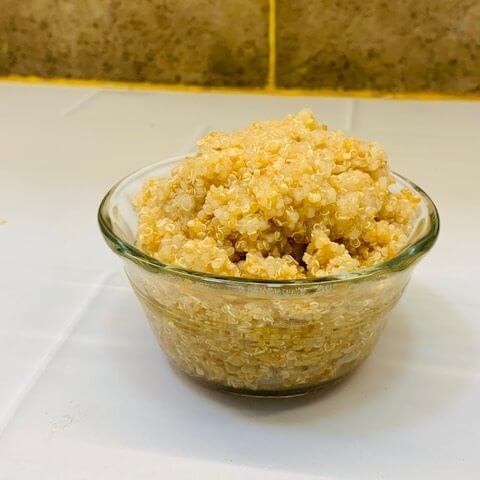QUINOA

Quinoa is gluten-free and packed with nutrients like protein, zinc, fiber, and folate, as well as antioxidants. Quinoa doesn’t take long to prepare, and you can add it to your diet in both sweet and savory dishes. Quinoa has gained popularity as a health food in the United States and other Westernized countries. Quinoa’s popularity has grown exponentially as the demand for easy-to- grow, nutritious, gluten-free grain alternatives has soared.
Nutritional Count Of Quinoa (1 Cup Cooked Quinoa/ 185g)
- Calories – 222 kcal
- Protein – 8.14g
- Fiber – 5.18g
- Fats – 3.5g
- Carbohydrates – 39.4g
Packed With Nutrition
- Quinoa is a grain crop grown for its edible seeds. Although it’s usually lumped in with cereal grains, like oats and barley, quinoa is actually a pseudocereal grain. In other words, it is basically a seed that is prepared and eaten similarly to a grain. Other examples of pseudocereal grains include buckwheat and amaranth. There are many types of quinoa, including red, black, and white. It’s also rich in fiber and protein, nutrients that play an important role in helping you feel full.
Improves Digestive Health
- Quinoa is a great source of fiber. Fiber can prevent or treat constipation and may lower your risk of intestinal cancers. It also helps you feel full longer, so it may help with weight loss. Quinoa has more protein and fiber. These nutrients can help you lose weight and are critical for weight loss and weight maintenance. Quinoa has a lower GI score and is expected to have less impact on your blood sugars than other similar carbs.
Good For Gut
- Fiber, an essential component for health, is abundant in quinoa. Your diet may benefit from including more fiber-rich foods if you want to maintain your weight and promote intestinal health. Quinoa may improve gut health by enhancing the diversity of beneficial gut bacteria and reducing the inflammatory symptoms of conditions like colitis. Acting as a prebiotic, Quinoa supplies the fuel for beneficial gut bacteria, allowing them to thrive.
Gluten Free
- Some people with gluten intolerance, including those with celiac disease and non-celiac gluten sensitivity, need to avoid foods containing gluten. People following a gluten-free diet need to choose gluten-free alternatives to gluten-containing grains like wheat, barley, and rye. Quinoa is naturally gluten-free and makes a nutritious choice for people who want to or need to cut gluten from their diet. Unlike gluten-free products made with refined ingredients, quinoa is a good source of nutrients that gluten-free diets often lack, like Fiber, Folate, Zinc, Magnesium.
High In Protein
- Quinoa is a good source of protein, providing 8 grams per cooked cup. Quinoa is often referred to as a complete protein. This is because it contains all nine of the essential amino acids that your body can’t make on its own. Quinoa can be considered a “nearly complete” protein, not a complete protein. Either way, quinoa is a good source of protein — and incorporating quinoa into your diet can help you meet your daily protein needs. This is especially true for those who follow plant-based diets, like vegans. You can make a plant-based, protein-rich meal in no time by combining quinoa with beans, tofu, and mixed vegetables.
- It is easy to incorporate quinoa into the diet. People can use it instead of rice in any recipe. Quinoa has a subtle nutty taste that makes it a very versatile ingredient. It can play a role in baking or as a breakfast grain. Quinoa also works well in hot side dishes, cold salads, and burgers. A fun fact about eating quinoa is Quinoa can be consumed anytime – at breakfast, lunch or dinner. But it is best to eat healthy food like quinoa before going to bed. It induces sleep, because it relaxes the muscles, due to its high magnesium and protein content


